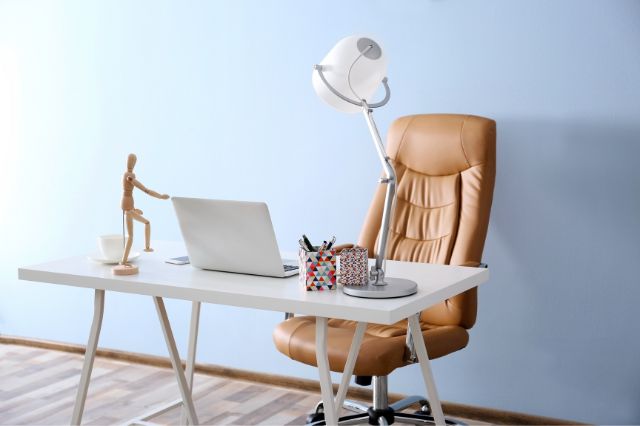The modern workspace is evolving, with a growing emphasis on health, comfort, and productivity.
This evolution has sparked a debate about the merits of standing desks and ergonomic office chairs, considering there are branded options like the Humanscale chair. In navigating this choice, it’s crucial to understand the unique benefits and peculiarities of each, aiming for a solution that enhances your work experience.
So, read on and find which is the best choice for you.
Standing Desks: A Shift in Work Dynamics
Standing desks represent a significant shift away from traditional sedentary work habits. They promote standing rather than sitting, linked to numerous health benefits, including reduced risk of obesity, heart disease, and lower back pain.
The logic is compelling: standing will likely burn more calories, improve posture, and enhance productivity through increased energy levels. However, it’s essential to note that transitioning to a standing desk may require some time for your body to adjust to the new posture and movement patterns.
While the initial discomfort or fatigue may be experienced, it’s important to persevere through this adjustment period, as the long-term benefits can significantly outweigh the temporary challenges.
Additionally, incorporating anti-fatigue mats or supportive footwear can help alleviate discomfort during prolonged periods of standing, further enhancing the ergonomic benefits of a standing desk setup.
The Comfort and Support of Ergonomic Office Chairs
Ergonomic office chairs focus on providing tailored support to the body during seated work. These chairs are designed to support the natural curve of your spine, promote good posture, and reduce strain on your body.
High-quality ergonomic office chairs are adjustable in multiple ways, allowing for a personalized fit that can significantly reduce the risk of musculoskeletal problems. Additionally, ergonomic chairs often come with features like lumbar support and adjustable armrests, further enhancing comfort during extended periods of sitting.
Investing in a quality ergonomic chair is beneficial for your immediate comfort and your long-term health and productivity. Remember, your chair is where you spend the majority of your workday, so it’s worth prioritizing comfort and support to minimize the risk of discomfort and injury.
The Hybrid Approach: Finding Balance
The conversation shouldn’t be about standing desks vs. ergonomic office chairs in isolation but how each can complement the other. A balanced approach might include using a standing desk for part of the day to benefit from mobility and alertness and an ergo chair when sitting is necessary.
This provides the support and comfort your body needs. This hybrid approach encourages regular posture changes, benefiting your physical health and mental focus. Moreover, incorporating movement breaks and stretching exercises into your work routine can further enhance the benefits of both standing and sitting.
By alternating between sitting and standing throughout the day, you can reduce the risk of prolonged sedentary behavior while maximizing comfort and productivity.
Personal Preferences and Health Considerations
Choosing between a standing office table and an ergonomic office chair—or deciding to use both—depends heavily on personal health considerations and work habits. For example, individuals with pre-existing back conditions may find that an ergonomic office chair offers necessary support.
This becomes better when coupled with the flexibility of a standing desk for short intervals. The key is listening to your body and adjusting based on comfort, productivity, and health.
Additionally, consulting with a healthcare professional or ergonomic specialist can provide valuable insights into the best ergonomic solutions for your specific needs and preferences.
It’s important to prioritize your health and well-being when making decisions about your workspace setup, as investing in ergonomic solutions can have significant long-term benefits for your physical health and productivity.
Implementing Your Choice in the Workspace
Transitioning to a standing desk or an ergonomic office chair requires a period of adjustment. For standing desks, it’s advisable to start with shorter intervals of standing, gradually increasing them as your body adapts.
For ergonomic office chairs, take the time to adjust the chair to fit your body correctly, maximizing the ergonomic benefits. Remember, the goal is to enhance comfort and reduce strain, so be patient and allow your body to guide the process.
Incorporating movement breaks and ergonomic accessories like footrests or monitor stands can further optimize your workspace setup for maximum comfort and productivity. By taking proactive steps to create a comfortable and ergonomic workspace, you can minimize the risk of discomfort and injury while maximizing your potential for focus and productivity.
The debate between standing desks and ergonomic office chairs is not about choosing one over the other but understanding how each can serve your needs.
A personalized and flexible approach, possibly incorporating both options into your workspace, can provide the best of both worlds, especially when you get furniture from reliable options like the Humanscale chair.
So, listen to your body, consider your work habits, and choose the solutions that best support your health and productivity goals. Remember, investing in ergonomic furniture and adopting healthy work habits is an investment in your long-term well-being and performance.
By prioritizing comfort, support, and movement in your workspace, you can create an environment that empowers you to thrive both professionally and personally.
